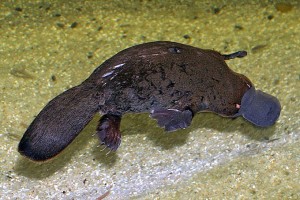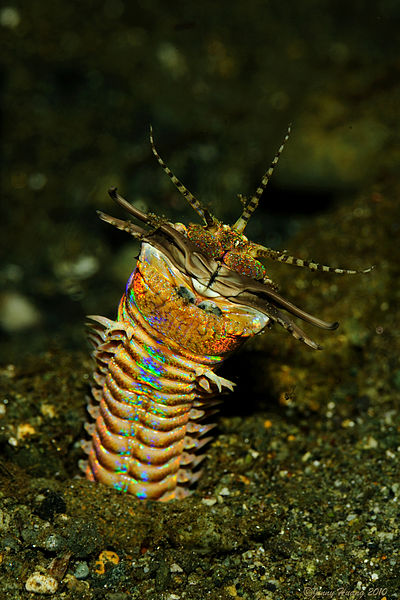Evolution, just for fun
Evolution: The first 2.5 billion years were boring
Science has determined single-celled organisms appeared on Earth roughly four billion years ago, and that for the next 2.5 billion years that’s all there was. I’m pretty sure our planet got a little bored towards the end there. But once multicellular life did show up, it was restricted to water, and so it was another billion years before anything interesting slithered onto dry land. More recently, that is, over the last 400 million years or so, the whole planetary creation process looks like it has gotten a lot more enjoyable than in those early times.

Exhibit A: the platypus–“an adorable, egg-laying muskrat-duck combo” clearly made from leftover parts. Photo: Stefan Kraft, Creative Commons, some rights reservedreserved
Take platypuses, (or platypodes if you want the correct Greek pedantic plural, and a Scrabble advantage), for example. With all due respect to these amazing animals, just the sight of one can provoke mirth. You have to wonder if Mother Nature shopped at Ikea when creating the animals, and after they had all been assembled, there was a little pile of washers, bolts and animal parts left over on the workbench. It must have seemed a shame to waste them, and so with a little force, and probably a stapler, they fit together (more or less) to form an adorable, egg-laying muskrat-duck combo.
“Like giving Peter Rabbit poison fangs”
And the hilarity doesn’t stop there. These docile-looking, essentially toothless creatures are venomous. It’s like giving Peter Rabbit poison fangs. The male has a pair of leg spurs that can deliver a cysteine-rich protein cocktail potent enough to kill a dog, and to cause severe and long-lasting pain in humans. To be fair to the platypus, it is not aggressive in the least. Perhaps evolution had interns doing the design work back in the day, because although the female platypus has a matched set of ovaries, only the left one works. Ever. This left-ovary issue puzzled me until I realized, of course—the beast was likely made from leftovers.

The pangolin: “if you got an aardvark to mate with a globe artichoke.” Photo: Piekfrosch, Creative Commons, some rights reserved
Old Ma Nature must have been in the mood for a visual gag when the pangolin, a golden-brown, armor-plated insectivore native to parts of Africa and Asia, was invented. It’s like she got an aardvark to mate with a globe artichoke to produce a scaly, thick-tailed creature with a defensive skunk-like spray and the ability to ball itself up like a pill bug when threatened. While it resembles armadillos and anteaters, not to mention dragons, DNA testing indicates it may be more closely related to cats. (If the dragon genome ever gets mapped I’m sure it will prove to be related to these as well).
“The planet got a billion-year head start experimenting with making slimy stuff”
Marine life, of course, is deeply bizarre, as the planet got a billion-year head start experimenting with making slimy stuff. Really, I find it remarkable that people actually swim in the sea. Why Mother Nature stocked the oceans with nightmares like glow-in-the-dark anglerfish and vampire squid is beyond me. And those are the benign ones. She has cone snails which deliver a tiny sting you don’t feel until a few days later, just before you die. Deadly box jellyfish, lethal stonefish, Portuguese man-o-war—if you ask me, the surf is kind of a La Brea Tar Pits for drunk college kids on break and old guys in Speedos. Which in the latter case may be acceptable.

The flashy Eunice aphroditois, a.k.a. the Bobbitt worm, can reach 10 feet in length and has the pleasant habit of slicing prey in half. Plus, of course, there’s the whole lethal toxin thing. Photo: Jenny, Creative Commons, some rights reserved
There is a sea worm called Eunice aphroditois which owns lightning reflexes, and razor-sharp scissors for jaws. And it’s big—a recently discovered specimen in Japan measured nearly ten feet long. Affectionately dubbed the Bobbitt worm, this lovely is capable of slicing corals and fish clean in half. For larger prey, animals many times its size on occasion, it injects a powerful toxin that can reportedly numb a human permanently. (How that is known, I haven’t a clue, although I have certainly met people who appeared so afflicted.)

The common octopus, uncommon in too many ways to count. Illustration: Comingio Merculiano, public domain
Octopuses, or octopodes if you like, are the envy of Cirque du Soleil with their ability to change shape, color and texture at will, and even shed an arm-tip if they slam it in a car door or something. Their 1,600 suction cups have evolved to escape from aquariums, but also to smell, and to store memories (Don’t ask me how this works—National Geographic prints it and I just pass it along). Recently we have been told these intelligent creatures were seen using tools, which is great news because we know who to hire for home repairs. They’re adept at building shelters out of coconut shells right now, but who knows—they might get the hang of impact drivers and belt sanders if you give them the chance.
“At that age, guys have the emotional maturity of a turnip”
Hammering together weird life-forms for fun is one thing; messing around with their behavior is another. Consider the fact that human females have the strongest drive to start a family—that is, the highest estrogen levels—in their late twenties and early thirties, while males have the highest testosterone around eighteen. At that age, guys have the emotional maturity of a turnip, at best. So how was this arrangement intended to work out for the continuation of our species? Maybe so-called “cougars” are part of the natural order. Honestly, though, I think it was just for yuks. Evolution works nicely, but can be kind of tedious. Even the forces of nature need a good laugh sometimes.
Paul Hetzler is a horticulture and natural resources educator with Cornell Cooperative Extension of St. Lawrence County.









Actually, if you take an objective look at the human animal, we do look rather odd, especially when you go below the surface of the skin.
The most beautiful animals on the planet are the cats.
Thanks for a fun column. I happen to know that NCPR’s Todd Moe has always wanted to know whether the deep-sea angler fish “knows” that it’s wiggling the worm-like lure dangling from its head. Perhaps you can write a column about that, just for Todd?
Paul, An anglerfish article? Sure; I’m always up for a challenge. Maybe I’ll time it for opening day of fishing season next spring. Take good care.
What a hoot! If Paul Hetzler wrote evolution and zoology textbooks, I would have continued to pursue a career in biology.
“Science has determined”
But it has not proven conclusively. Science has yet to prove what component in the primordial soup that all life was suppose to spring from had the drive or instinct to strive to not only survive, but mutate into higher complex lifeforms.
If bio-genesis and evolution are the product of a undetermined, uncaring, and non-intelligent universe, how then can any motivation based on instinct, intelligence, or emotion exist in a single cell life form to push it to evolve where we are today? More important, if we have sprung from inanimate, non-sentient, unthinking elements, how can even scientists credit their results as being logical or true? Darwin himself, which this article displays a figure of, admitted in his own autobiography that he was disturbed by the very thought that man’s reasoning, and hence his own, was undermined from the start becasue of this point, making him even doubt his own reasoning and theory.
Jim,
Thanks for the best compliment I have ever gotten.